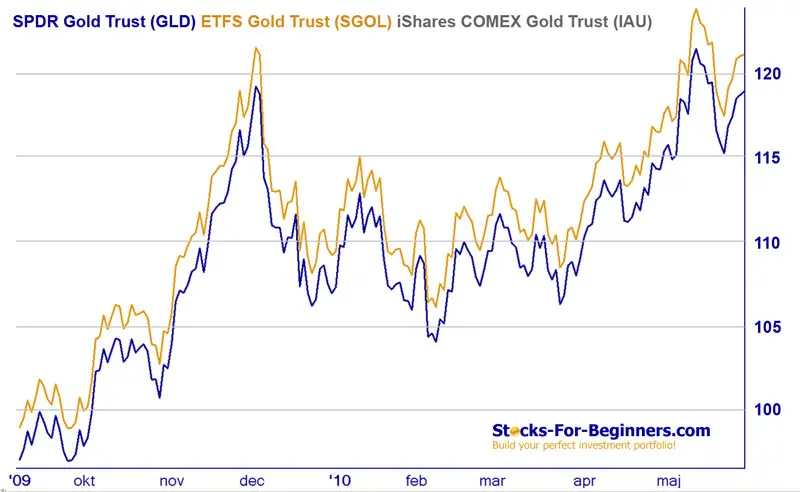Gold Index ETFs - Comparison of Primary Gold Funds Backed by Physical Gold
We have compared for you three primary gold index ETFs backed by physical gold: SPDR Gold Shares (GLD), ETFS Physical Swiss Gold Shares (SGOL) and iShares COMEX Gold Trust (IAU).
ETFs following the price movement of gold index are one of many possibilities of getting exposure to gold (Where To Buy Gold?). Some ETFs are backed with physical gold, while others invest in futures or gold mining companies. The most precise exposure to price movement of gold offer physical gold ETFs, which are also the most secure investment.

The value of gold index, which is primarily driven by demand and supply of physical gold, is continuously rising in last few years mostly because of investors' concerns about declining purchasing power and inflation spur investment or any other reason (Why Invest In Gold?).
Three Primary Gold Index ETFs Backed by Physical Gold
Three primary gold index ETFs exist, which are all backed by physical gold and have the same objective: SPDR Gold Shares (GLD), ETFS Physical Swiss Gold Shares (SGOL) and iShares COMEX Gold Trust (IAU).
They are all designed to track the price of gold net of trust expenses, they all trade on the New York Stock Exchange Arca with minimum order size of 1 share, they are all based on the price of 1/10th of an ounce of gold and they are all eligible for margin and short selling. So where are the differences among them?
| Name | SPDR Gold Trust | ETFS Physical Swiss Gold Shares | iShares COMEX Gold Trust |
|---|---|---|---|
| Inception Date | 11-18-2004 | 09-09-2009 | 01-21-2005 |
| Symbol | GLD | SGOL | IAU |
| Estimated Expense | 0.40% | 0.39% | 0.40% |
| Custodian | HSBC Bank (USA) | JPMorgan Chase Bank Zurich Sub-Custodian: UBS A.G. |
In the vicinity of New York, Toronto, Montreal, London and London |
| Prospect | spdrgoldshares.com | etfsecurities.com | ishares.com |
| Average Daily Volume (52-week) | 16,423,432 | 115,816 | 309,803 |
| Price (05-28-2010) | $118.88 | $121.10 | $118.89 |
| Market Capitalization | $46,410,000,000 | $425,010,000 | $3,281,419,881 |
Source: ETFs Prospects, ETFs WebSites & Google Finance
Direct Comparison of ETFs
Performance
GLD, IAU and SGOL all perform almost exactly the same, which is very close to gold itself. You can check Real-Time charts on Google Finance.

Assets
While GLD may be the largest physical gold ETF with $46.4 billion in assets at the end of May 2010, it is not the only U.S. ETF to be backed by physical gold holdings. iShares Comex Gold (IAU) had $3.3 billion in assets on the same date. ETF Securities, whose founder launched the first physically backed gold fund in Australia in 2003, has also grabbed a slice of the pie with its U.S. gold fund. The company's Physical Swiss Gold Shares (SGOL) launched on Sept. 9, 2009, and has already attracted more than $425 million in assets as of 05-31-2010.
Trading Volume
GLD is the largest fund when measured by assets and also has the highest trading volume. GLD's 52-weeks average daily trading volume is more than 16 million shares. IAU has a 52-weeks average daily trading volume of around 310,000 shares, while SGOL has an average daily trading volume of around 116,000.
Liquidity is an important factor when deciding between similar ETF funds, but all three of these physically backed gold index ETFs have very high trading volume. Because the average investor would not have difficulty trading in or out of any of these three funds, the decision may come down to fees and storage.
Management Fees
All three funds have a similar structure and fee schedule. GLD and IAU both have management fees of 0.40%, while newcomer SGOL has a 0.39% fee. All three funds offer investors exposure to a physical stockpile of gold held for investors by the trust.
Those investors who are frequently trading physically backed gold ETFs on their own may find SGOL's small difference in management fees to be the deciding factor. Investors who are comfortable with only the biggest funds might choose GLD instead.
Gold Storage Location
The biggest difference between the funds is size and where the gold is stored. SGOL's gold bullion is held in Zurich, Switzerland. All of the vaults that contain this gold are approved by the London Bullion Market Association (LBMA) to meet "good delivery standards."
The gold that underlies GLD is held in the form of allocated 400-ounce London Good Delivery bars in the London vault of HSBC (HBC) Bank USA, or in the vaults of subcustodians. GLD's gold bars are also held to the "good delivery standards" of LMBA.
Shares of IAU are backed by gold held by the custodian in the vicinity of New York, Toronto, Montreal, London and potentially other locations in the future. Gold held for IAU meets the same LMBA standards as GLD and SGOL.
Auditor Inspection
Gold bullion held for the SGOL fund is inspected twice a year by an external auditor, and gold bar identification numbers are published on the fund's Web site. The trustees of GLD are allowed to inspect the gold holdings in the vault twice a year as part of their audit of the Financial Statements of the Trust. IAU also has the option to inspect the gold or have independent auditors inspect the gold.
Investors who like guaranteed outside audits might prefer SGOL's process.
Written by: Goran Dolenc
Do you find this content useful? Like! Tweet! Recommend! Share!
Related Articles

Commodity ETF - Opportunity or Threat?
Commodity ETF (Exchange Traded Fund) has been quickly gaining popularity in last couple of years while giving private investors chance to expose to commodities.

Silver Fund ETFs - Comparison of Primary SLV Funds Backed by Physical Silver
Silver fund ETF represent a quick and easy way for an investor to gain exposure to the silver price. We have compared for you two primary silver fund ETFs: SLV and SIVR.
Back from Gold Index to Commodities Market
Back from Gold Index to Best Online Trading Site for Beginners home page







